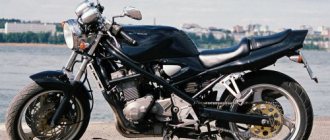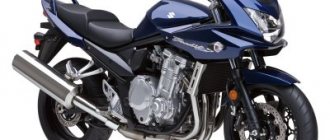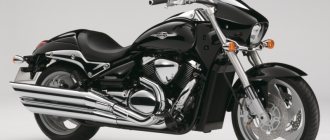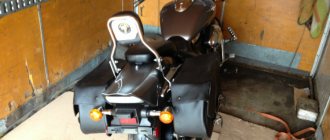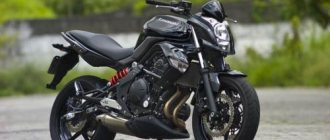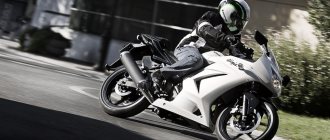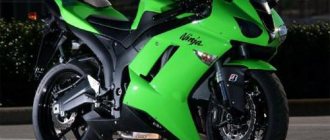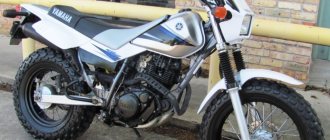2011 – Kawasaki Ninja 1000 vs. Suzuki GSX1250FA and Yamaha FZ1
Three of the best sportbikes you can ride without cramped legs or sore wrists.
What started out as a simple duel between the Kawasaki Ninja 1000 and the 2011 Yamaha FZ1 turned into a truly exciting showdown when the 2011 Suzuki GSX1250FA entered the fray. Newcomer Suzuki pushed the boundaries of the first two bikes' judging criteria, helping to highlight the flaws and shortcomings that balanced them out. advantages.
Introduced this year, the Kawasaki Ninja 1000 and Suzuki GSX1250FA are the latest models in the trio. The updated Suzuki Bandit now features a full fairing and ABS as standard, which is more typical for the sport-touring class than for a sportbike.
The Ninja has more sporty features and a powerful four-cylinder Z1000 engine, which, however, does not guarantee absolute superiority over other rivals. Each of our test riders had their own opinion on why the motorcycle they liked should take the top spot. The renamed Bandit Suzuki GSX and the rather old (since 2006) Yamaha FZ1 have an advantage in some details over the Ninja, whose developers probably forgot to implement something that every liter sportbike simply must have.
Where exactly the Ninja Z1000 has the upper hand over the Yamaha is the engine, which is even more powerful. The Kawasaki six-speed had me on the Yamaha counting the seconds until the four-cylinder FZ1 revs. At some point the R1 engine finally reached the peak of its power and acceleration was impressive, but by this time the Z1000 was already a long way off. The FZ1 itself is very fast, but compared to the new Ninja, it feels a little sluggish until it accelerates, of course.
“A motorcycle engine is a key aspect of fast, dynamic riding and in this regard the Ninja engine is as good as ever,” said one rider named Duke. It easily outperforms the Yamaha at low revs, and its short gears have always been a standout feature. Kawi will win any race, I'm sure."
The GSX1250FA, with its 98 Nm of torque at 3500 rpm, wins over the Ninja, which has 97 Nm at 7800 rpm. But the Suzuki's curb weight is 257.2kg, making it almost 29kg heavier than the Kawasaki (228kg) and 36.3kg heavier than the FZ1 (220.9kg). With a torque band that starts at 92.1Nm at 2700rpm and rises all the way to 6800rpm, the GSX is undoubtedly the leader in this area among our three bikes. But where the Suzuki clearly falls short is horsepower output: 92.6 hp at 8,800 rpm, while the Ninja's 121.1 hp at 10,100 rpm and the FZ's 125.1 hp at 11300 rpm.
To say that Kawasaki has a great engine is an understatement. The new Ninja 1000 has the perfect combination of sportbike performance that allows it to be used in urban environments. According to leading sports publications: “The Ninja 1000 has the most outstanding sportbike look possible. Kawasaki has developed and produced a powerful engine that can be used in the city every day. This bike has the most low- and mid-range torque of any sportbike we've ridden."
Considering the Suzuki's 1255cc engine capacity (79.0 x 64.0mm bore and stroke), horsepower numbers below 100 are somewhat disappointing, but well masked by phenomenal low-end torque.
The Ninja and FZ1 share the same 77.0mm piston bore, but the Kawi's engine is slightly larger (1043 vs. 998cc) and also has a higher compression ratio (11.8:1 vs. 11.5:1). In combination with different camshaft profiles, this explains the difference in power characteristics. If you prefer a more track-oriented sportbike, the FZ1 is your choice, but for more casual riding, the Ninja or GSX is preferable.
In terms of riding position and distance from the seat to the pegs, it's hard to tell the difference - all three bikes can confidently score gold stars in the comfort department. But for long and long trips, we would still choose Suzuki.
“The Suzuki 1250FA is a great sport tourer,” notes Boomer. This is the most comfortable motorcycle in the test, and I would say, in general, of motorcycles of this type. What’s also great is that the bike handles bumps and bumps on the road very well.”
Ergonomics and controls
Suzuki and Yamaha lose out to Kawasaki in gas tank design. The Ninja's tank is flat and comfortable, conveying a sense of control over the bike, while the FZ1's tank is large, and the GSX's has an awkward protrusion where it mounts to the frame.
“In terms of comfort, the difference between the Kawasaki Ninja Z1000 and the FZ1 is not very noticeable,” notes tester Kevin. The Yamaha's seat feels a little firmer, the handlebar position on both is very motocross-like, and the vibration damping seems fairly acceptable on both the Ninja and FZ1."
Additional comfort on the Kawasaki is provided by a windshield that has three manual adjustment positions. In the lower position, the best aerodynamic characteristics are achieved, while increasing the force of the wind flow on the driver, which is no less important on hot and stuffy days. The high position accordingly reduces exposure to cold air. My height is 180 cm, and with the glass in the lower position I felt the impact of incoming air currents on my chest, and with the glass in the upper position - in the area of the collarbones, and surprisingly - no effects of turbulence!
The Yamaha windshield is certainly functional, but here the wind flow is controlled by the rise and fall of your body. In terms of wind protection, the Fizzer's functionality is quite modest, falling between its class and being a naked streetfighter. But full wind protection gave a new look to the Suzuki Bandit model, the body of which, although it reliably sheltered the lower part of the body from the wind, was unlikely to receive any award for style.
Yamaha and Suzuki are equipped with a centerstand, which will appeal to motorcyclists who like to maintain their machines themselves, while Kawasaki lacks this, which may be due to the desire to reduce weight (Yamaha weighs about 221 kg, Kawasaki 228.1 kg), or maybe due to ground clearance In any case, a motorcycle equipped with a centerstand can easily be maintained by one person, which would be quite difficult to do without it.
Additionally, the FZ1 has fairly easy access to the engine, while the Ninja and GSX have most of the body kit's plastic parts that must be removed for even the most basic servicing. But the presence of these same body kit parts in the Ninja and GSX provides quite significant protection for the rider in rainy and cold weather. Of course, those who love open-engined motorcycles will prefer the shape and lines of the FZ1 over the plastic-laden Suzuki. But the most aggressive look of all three is Ninja.
In terms of handling, all three bikes performed well despite their weight, and cornering performance was fairly neutral. Considering the amount of fuel (about 19 liters or 13.6 kg) placed at the top of the frame, I personally expected them to be much heavier to handle. But of all three, the GSX still seemed a little heavier to some testers.
“The FA is a little longer and heavier than the rest of the bikes,” says Giardinelli, “it won’t turn as fast as other bikes, but it has a stable underpinnings that Suzuki have done a good job with.”
The Ninja has excellent steering response and excellent directional control, but we did notice a small flaw: when cornering, you need to turn the steering wheel a little to maintain the desired turning arc. This was especially noticeable after 4,000 km of our rather severe testing, and replacing the base Bridgestone BT-016s tires only slightly corrected the situation.
The FZ1 was hailed as the sportiest, but almost everyone was annoyed by its overly responsive throttle response. Yamaha has updated the ECU several times and it works much better than before, but some issues still remain. “The neat, smooth, controlled fuel management of the Yamaha's ECU makes it a challenge to tackle difficult sections of the trail,” Giardinelli observes.
At first glance, neither bike seemed to have a braking advantage, but the FZ1 has dual 320mm discs and four-piston calipers up front, which still provide slightly better stopping feel than the 300mm calipers. Kawasaki's dual front disc brakes with four-piston radial-mount calipers. Considering that the Suzuki weighs more than the rest, its brakes coped with their task no worse than its rivals, and it is worth noting that this is the only motorcycle of the comparison equipped with ABS.
Unlike the FZ1, the Ninja's 41mm inverted forks are pre-set to sport mode, although both bikes have fully adjustable forks, allowing anyone to tweak them to suit their preferences. At the rear, both the FZ1 and Ninja feature a preload- and rebound-adjustable shock absorber.
The GSX's weight sometimes punches through its suspension, but the preload-adjustable 43mm fork and rear shock (which has preload and rebound adjustment) are still up to the task in moderately aggressive conditions.
“I expected the 1250 to live up to its price tag, but it's definitely not at the top of the podium,” Smith notes of the Suzuki. On the way home I felt that the suspension was not as good as I thought."
In addition to the aforementioned ABS and centerstand, the GSX is equipped with a gear position indicator, an adjustable clutch lever (all three bikes have an adjustable front brake lever) and a helmet mount. The FZ has a centerstand and side rails, but no helmet mount, while the Ninja Z1000 only has side rails.
“The Kawasaki Ninja is a great bike, it seems to have everything in place for the rider's comfort, so the lack of a helmet mount or at least hooks is a glaring omission, as it is great for both casual commuting and sports touring.” , notes the picky Duke.
The most comfortable passenger seating was found on the Suzuki. Its seat is quite low and has the best combination of comfort and support, providing neutral-upright ergonomics. The Kawasaki has a slightly leaner stance and is more comfortable to hold onto the handles during, for example, aggressive braking.
For those who love to travel and need luggage, Suzuki offers optional hard saddlebags and a 37-liter overhead storage bin. Yamaha offers top drawers with different volumes - 40, 45 and 50 liters. The Kawasaki can be equipped with 35 liter lockable hard bags.
Prices and Summary
The prices of these three sportbikes are quite an interesting aspect. The GSX1250FA is equipped with ABS, but the $11,599 asking price still seems a bit steep for a bike that lacks any high-tech features and differs from its predecessor models only in appearance. The FZ1 has the lowest price of the three at $10,490, but its engine is atrocious.
The Ninja Z1000 sits in the middle with its $10,999 price tag, and after carefully weighing the pros and cons of each bike compared, I would choose it for its distinct balance of sporty aggression and touring comfort.
However, there are other opinions on this matter, let's see what Smith and Giardinelli have to say.
“I liked the Yamaha FZ1 the most,” said Giardinelli. Its engine isn't as buzzy as the Ninja 1000's and it's more nimble than the big Suzuki 1250FA. In general, it is comfortable, has decent wind protection, and the power is also at the level (except for low revs). Of course, it will not be the favorite in its category for a number of reasons, but many things in it are done at a high level.”
As for Smith, he would have chosen the Ninja if he didn't already have a Gixxer 1000 in his garage. He also thinks the GSX1250FA is a decent bike.
“I completely understand the appeal of motorcycles like the FZ1 or Ninja,” says the former motorcycle magazine editor. The latter, by the way, really corresponds to the concept of a modern sportbike designed for city riding. But so far they don’t quite suit my preferences (and my wallet too). Of the three, only the Suzuki can make me want to drop everything and go somewhere else.”
“This bike can easily go coast-to-coast or border-to-border, and it feels like a motorcycle in the corners,” continues Smith. I could call it a “sportbike for every day.”
Giardinelli didn't pick the GSX as his favorite, giving that spot to the Ninja, but he has an idea of who the bike would be a great fit for. “If you like the comfort of a Honda ST1300 or BMW RT, but don't need sporty performance, this is the bike for you.”
Duke also opted for a Kawasaki Ninja Z1000, and while it's not exactly perfect, its comfortable sportiness makes it a good choice for a sportbike enthusiast.
“I bet you anything, but this bike is the fastest liter sportbike,” says Duke. Its engine rumble and transmission ratios are more than suited for street driving, and its relatively upright driving position is best suited for rough roads.”
Conclusion
Suzuki GSF 250 is the last of the Mohicans, a bright representative of a bygone era. They haven’t made motorcycles like this for a long time, because savings have come first. And the 250cc Bandit was created by engineers, not marketers , and even now it could easily outshine all modern competitors in the same class.
Specifications
| Maximum engine power: | 45.0 hp (33.1 kW) at 14500 rpm - GSF250 (1989-1992), 40.0 hp (29.4 kW) at 13500 rpm – GSF250 (1993-2000) HP |
| Torque: | 25.0 Nm (2.6 kg*m) at 10500 rpm - GSF250 (1989-1992), 26.0 Nm (2.7 kg*m) at 10000 rpm - GSF250 (1993-2000) Nm |
| Working volume: | 248 cm3 |
| Motor type (cylinder arrangement, number of strokes): | 4-cylinder, 4-stroke, in-line |
| Number of cylinders: | 4 |
| Number of valves: | |
| Intake type (Injector / Carburetor): | |
| Bore and stroke: | |
| Starting system (Electric starter, kick starter): | |
| Maximum speed in km/h: | 180 km/h |
| Cooling system: | Liquid cooling |
| Transmission (gearbox): | Mechanical, 6-speed |
| Clutch (Dry / Wet): | |
| Drive unit: | Chain |
| Frame: | Steel tubular |
| Chassis | |
| Suspension (front/rear travel): | |
| Brakes (Front/Rear): | |
| Wheels / Tires / Rubber: | |
| Dimensions and weight | |
| Dimensions (Length / Width): | |
| Seat height: | |
| Ground clearance: | |
| Curb weight: | |
| Wheelbase: | 1435 mm – GJ74A, 1415 mm – GJ77A mm |
| Weight: | 146 kg |
| Fuel tank capacity: | 14.0 l – GJ74A, 15.0 l – GJ77A l. |
| Battery capacity: | |
| Year of release: | |
| Country of Origin: |
